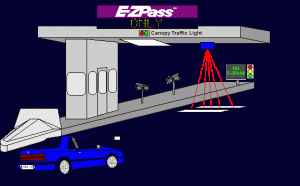 Our recent discussions of queuing in class have made me think a lot more about examples of queuing within transportation systems we frequently use. One queuing-related technology that is especially interesting to me is E-ZPass. As you probably know, this is an electronic toll collection system used throughout the northeast which relies on wireless technology to read transponders placed in cars through the toll plaza. Conventional E-ZPass installations have been very successful at decreasing wait times at toll plazas, with further decreases in congestion possible through the use of high speed E-ZPass lanes, which can collect fares at near highway speed.
Our recent discussions of queuing in class have made me think a lot more about examples of queuing within transportation systems we frequently use. One queuing-related technology that is especially interesting to me is E-ZPass. As you probably know, this is an electronic toll collection system used throughout the northeast which relies on wireless technology to read transponders placed in cars through the toll plaza. Conventional E-ZPass installations have been very successful at decreasing wait times at toll plazas, with further decreases in congestion possible through the use of high speed E-ZPass lanes, which can collect fares at near highway speed.
History
The first electronic toll collection system was implemented in Colorado in 1991. Around this same time, various toll collection agencies in and around the city of New York were working to develop their own electronic toll collection system to decrease congestion on some of the most heavily travelled roadways in the united states. The E-ZPass system was first deployed in 1993, and saw rapid expansion of usage following that time. Many other states in the northeast such as Massachusetts and Maryland created similar systems soon after and over time they were modified for inter-compatibility. Following the rebranding Massachusetts’s “Fast Lane” system in 2012, all electronic toll systems in the northeast operate under the E-ZPass brand.

Benefits
The primary benefit from the use of E-ZPass is the decrease in congestion at toll plazas. Instead of waiting for an attendant to process the transaction, or for the driver of the vehicle to fumble around for exact change, drivers can pass directly through the toll at between 5 and 15 mph, without having to take their hands off the wheel or focus on anything except driving. This means that less attendants are required, decreasing the cost to toll agencies. The wait times are further decreased in areas where high speed E-ZPass lanes are used, which allow cars to pass through the plaza at near highway speeds. This allows the toll plaza to meet the demand of customers no matter what the demand volume might be. While decreased congestion is the most obvious effect, the decrease in pollution and savings in gas that result from less vehicles waiting at the toll. Hopefully in the future these systems will be built into cars or license plates, so that every car on the road can use this electronic toll system. If all cars on the road were using this, we could eliminate the costs associated with staffing toll plazas, excessive vehicle idling, and other costs that long waits cause.
Sources:
- http://www.e-zpassiag.com/
- http://en.wikipedia.org/wiki/E-ZPass
- http://www.e-zpassiag.com/images/about_us/lane.gif
- http://en.wikipedia.org/wiki/File:EZPass_logo.svg

I don’t remember the time before E-ZPass but I am certain that approaching a toll plaza would be nothing short of miserable. E-ZPass revolutionized highway transportation by reducing on travel times and as you mentioned, keeping drivers focused on the road. I was unable to find statistics but I feel that accidents around toll plazas decreased significantly after the installation of transponder scanners. Drivers can maintain full attention on the road rather than fumbling around in wallets, purses and cup holders looking for change. EZ-Pass is a fantastic example of making a transportation system more efficient.
I’d like to disagree on the point about decreased accidents after EZ-Pass was installed. Because not all vehicles have EZ-Pass, toll plazas generally have lanes for EZ-Pass only, cash only, and EZ-Pass or cash (or some combination of these). This forces many vehicles to quickly change lanes, all at the same time. Sounds like an unsafe situation to me. The question, then, is what to do about it. Could you mandate EZ-Pass, redesign your toll plaza, …?
http://www.wusa9.com/news/article/230021/373/Confusion-On-New-495-Express-Lanes-Causes-Multiple-Accidents
I think that EZ-Pass is a wonderful invention. I am much happier when I am in one of my parents’ cars with EZ-Pass rather than my own car without EZ-Pass because of the noticeable convenience difference. It does make me nervous sometimes trying to change to the correct lane when approaching a toll booth and I could easily see how many accidents could occur. Perhaps there is some way to alert drivers of the toll plaza and appropriate lanes earlier? This may be difficult in some areas because of the layout of the highway but I think it would prove helpful, providing that drivers pay attention to signs.